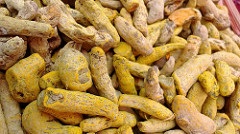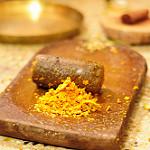Turmeric हल्दी (haldi) is the new natural healing rage in the West; from health food stores to cafes, you’ll find an abundance of items that claim enhanced nutrition value or health benefits due to हल्दी as an ingredient.

Dried turmeric. (Image by Anuandraj on Flickr.com)
However, हल्दी has been a part of an Indian household’s pantry for centuries. It is not only know to promote good health आरोग्य (aarogya), it is also used in a variety of daily rituals and auspicious traditions throughout India.
1. In cooking, हल्दी is used not only as a spice, but also for its antioxidant and anti-inflammatory properties.
2. When I was growing up, and even today, हल्दी दूध (haldi doodh) or हल्दी stirred into hot milk दूध was an effective remedy for a bad cough खांसी (khaansee).
3. Cuts, minor wounds घाव (ghaav) and scrapes खरोंच (kharonch) were effectively treated with an application of a हल्दी paste made with water.
4. हल्दी contains curcumin which gives it its golden yellow color. It is this property of हल्दी that is also said to make the skin त्वचा (tvachaa) glow. For this reason, it is believed that हल्दी is applied to the face, hands, and feet of a bride दुल्हन (dulhan) before the wedding.
हल्दी कुमकुम (haldi kumkum) is another tradition followed in some regions of India, where हल्दी and कुमकुम (kumkum) or vermilion are presented to married woman in acknowledgement of their marital status and to wish for its health and longevity. Although these events are social in nature, they are observed on religious or auspicious days in the Hindu calendar.
5. In South India, a weekly ritual involves the application of हल्दी mixed with sesame oil तिल का तेल (til ka tel) on one’s body, followed by a hot water bath. This ritual pursues the medicinal and curative benefits of turmeric.

Ground turmeric. (Image by saptarshikar on Flickr.com)
In more recent times, the हल्दी is mixed in its powdered form. However, in more traditional households, the हल्दी rhizome is ground on a rough stone to make a paste which is then applied to the body.
हल्दी has a unique and strong flavor which not everyone finds palatable. However, I have always loved the flavor of हल्दी in almost everything … especially hot steaming lentils दाल (daal) with rice and a huge dollop of ghee–it’s the closest I get to clean eating or a सात्विक (satvik) meal.







Comments:
Ian Rowcliffe:
Hi again, Nitya
I appreciate your ‘glimpses’ of Indian culture – आरोग्य and सात्विक specifically, both of which you might enlarge upon in future posts. That said, thanks for these very interesting points of departure. Ian
Nitya:
@Ian Rowcliffe Thank you Ian.
Kate:
Im so happy somebody posts something about common hindi ! Now I can finally learn the real terms